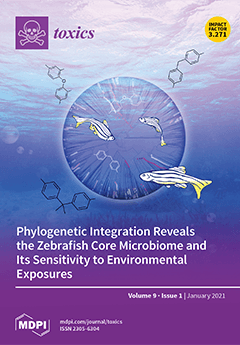The effects and underlying mechanisms of phthalates on neurotoxicity remain unclear as compared with the potentials of these substances as endocrine disruptors. The locomotor activities of zebrafish embryos were investigated upon exposure to six phthalates: dimethyl phthalate (DMP), diethyl phthalate (DEP), benzyl butyl
[...] Read more.
The effects and underlying mechanisms of phthalates on neurotoxicity remain unclear as compared with the potentials of these substances as endocrine disruptors. The locomotor activities of zebrafish embryos were investigated upon exposure to six phthalates: dimethyl phthalate (DMP), diethyl phthalate (DEP), benzyl butyl phthalate (BBzP), di-2-ethylhexyl phthalate (DEHP), di-n-octyl phthalate (DnOP), and diisononyl phthalate (DiNP). Moreover, changes in fluorescence intensity in the green fluorescent protein (GFP) transgenic (Tg) lines
Tg(HuC:eGFP),
Tg(sox10:eGFP), and
Tg(mbp:GFP) were measured after exposure to six phthalates, and changes in the expression profiles of genes involved in the cholinergic (
ache) and dopaminergic systems (
dat,
th, and
drd1b) were assessed. Exposure to BBzP, DEHP, and DiNP affected larval behaviors, whereas exposure to DMP, DEP, and DnOP revealed no alterations. A reduced expression of
Tg(HuC:eGFP) was observed upon exposure to BBzP, DEHP, and DiNP. The expression of
Tg(sox10:eGFP) and
Tg(mbp:GFP) was reduced only in response to BBzP and DiNP, respectively. Further, exposure to DiNP upregulated
ache and
drd1b. The upregulation of
ache and downregulation of
drd1b was observed in DEHP-exposed groups. Exposure to BBzP suppressed
th expression. These observations indicate that exposure to phthalates impaired embryogenesis of the neurological system and neurochemicals in zebrafish embryos, although the detailed mechanisms varied among the individual phthalates. Further mechanistic studies are needed to better understand the causality between phthalate exposure and neurotoxicity.
Full article






